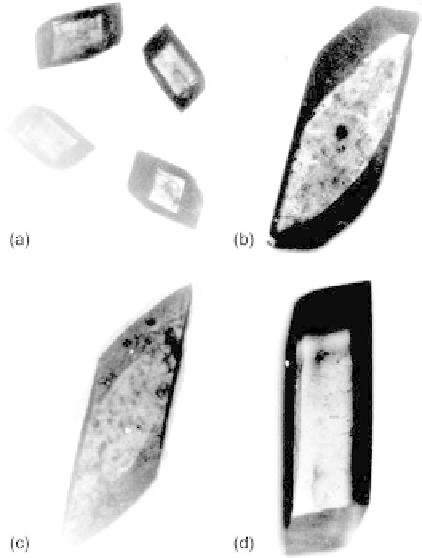Geoscience Reference
In-Depth Information
Figure 7.67 Photographs of NaHZn
(P
2
O
7
) crystals (magnification
3
30)
[297]
.
divalent and trivalent metals such as Al, Mn, Co, Ni, Zn, Cd, and Pb.
Table 7.25
gives cation properties. As evident from
Table 7.25
the Al is the smallest ion and it
shows excellent morphology (
Figure 7.64a
). The crystals are very well developed
and highly transparent. This is followed by Mn, which gives good crystals of an
excellent crystal habit. However, due to the susceptibility of Mn for the changes in
the valency with sudden changes in the experimental growth parameters, there is a
tendency for the formation of polymorphic modifications of Mn bearing pyropho-
sphates. But both the polymorphic modifications of Mn superionic pyrophosphates
show excellent morphology with well-developed habits, and smooth and vitreous
surfaces (
Figure 7.64a
).
The cobalt bearing superionic pyrophosphate shows probably the best morphol-
ogy (
Figure 7.64b
). The crystals are very well developed with vitreous and smooth
surfaces having a high degree of transparency. The size of the cobalt bearing pyro-
phosphate is higher than the other pyrophosphates of this class.
It is believed that all these superionic pyrophosphates belong to the same struc-
ture type, i.e., the triclinic, P1 space group. As the ionic size of the cations inserted
into the structure increases, there develops a general structural distortion, which in
turn affects the crystal morphology.
Table 7.26
gives the variation in bond lengths
of these pyrophosphates. As evident from
Table 7.26
, the difference in maximum
and minimum bond lengths of Na
a
O polyhedra increases gradually toward the Zn
end member. Thus,
toward the Pb end member,
the crystals become poorly


